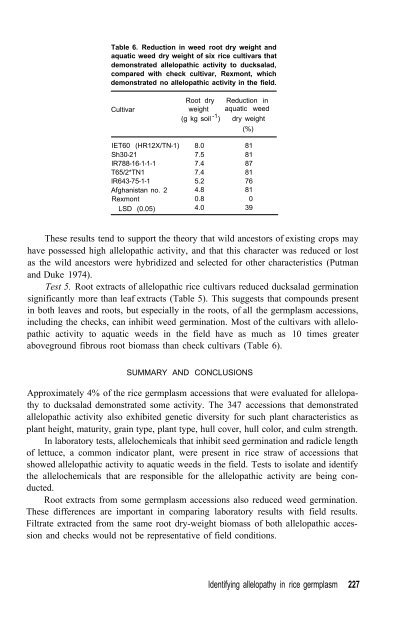HERBICIDES in Asian rice - IRRI books - International Rice ...
HERBICIDES in Asian rice - IRRI books - International Rice ...
HERBICIDES in Asian rice - IRRI books - International Rice ...
You also want an ePaper? Increase the reach of your titles
YUMPU automatically turns print PDFs into web optimized ePapers that Google loves.
Table 6. Reduction <strong>in</strong> weed root dry weight and<br />
aquatic weed dry weight of six <strong>rice</strong> cultivars that<br />
demonstrated allelopathic activity to ducksalad,<br />
compared with check cultivar, Rexmont, which<br />
demonstrated no allelopathic activity <strong>in</strong> the field.<br />
Cultivar<br />
Root dry Reduction <strong>in</strong><br />
weight aquatic weed<br />
(g kg soil -1 ) dry weight<br />
(%)<br />
IET60 (HR12X/TN-1) 8.0 81<br />
Sh30-21 7.5 81<br />
lR788-16-1-1-1 7.4 87<br />
T65/2*TN1 7.4 81<br />
lR643-75-1-1 5.2 76<br />
Afghanistan no. 2 4.8 81<br />
Rexmont 0.8 0<br />
LSD (0.05) 4.0 39<br />
These results tend to support the theory that wild ancestors of exist<strong>in</strong>g crops may<br />
have possessed high allelopathic activity, and that this character was reduced or lost<br />
as the wild ancestors were hybridized and selected for other characteristics (Putman<br />
and Duke 1974).<br />
Test 5. Root extracts of allelopathic <strong>rice</strong> cultivars reduced ducksalad germ<strong>in</strong>ation<br />
significantly more than leaf extracts (Table 5). This suggests that compounds present<br />
<strong>in</strong> both leaves and roots, but especially <strong>in</strong> the roots, of all the germplasm accessions,<br />
<strong>in</strong>clud<strong>in</strong>g the checks, can <strong>in</strong>hibit weed germ<strong>in</strong>ation. Most of the cultivars with allelopathic<br />
activity to aquatic weeds <strong>in</strong> the field have as much as 10 times greater<br />
aboveground fibrous root biomass than check cultivars (Table 6).<br />
SUMMARY AND CONCLUSIONS<br />
Approximately 4% of the <strong>rice</strong> germplasm accessions that were evaluated for allelopathy<br />
to ducksalad demonstrated some activity. The 347 accessions that demonstrated<br />
allelopathic activity also exhibited genetic diversity for such plant characteristics as<br />
plant height, maturity, gra<strong>in</strong> type, plant type, hull cover, hull color, and culm strength.<br />
In laboratory tests, allelochemicals that <strong>in</strong>hibit seed germ<strong>in</strong>ation and radicle length<br />
of lettuce, a common <strong>in</strong>dicator plant, were present <strong>in</strong> <strong>rice</strong> straw of accessions that<br />
showed allelopathic activity to aquatic weeds <strong>in</strong> the field. Tests to isolate and identify<br />
the allelochemicals that are responsible for the allelopathic activity are be<strong>in</strong>g conducted.<br />
Root extracts from some germplasm accessions also reduced weed germ<strong>in</strong>ation.<br />
These differences are important <strong>in</strong> compar<strong>in</strong>g laboratory results with field results.<br />
Filtrate extracted from the same root dry-weight biomass of both allelopathic accession<br />
and checks would not be representative of field conditions.<br />
Identify<strong>in</strong>g allelopathy <strong>in</strong> <strong>rice</strong> germplasm 227

















